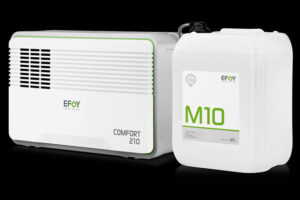 There are dozens of ways to charge the onboard batteries, each with pros and cons. Most of us burn some diesel by firing-up the engine or generator. Others rely on the sun for their solar panels or wind for their turbines. Sailors may have sail drive or shaft alternators on their inboard engines that turn the prop into a mini hydro-turbine. There are even towable units that are basically small hydroelectric power plants. The power parade is endless and some boat owners have gotten quite inventive with a diverse electrical breadbasket. Engines and generators are loud and pollute, solar and wind output is married to nature’s whims. What if there was a silent, environmentally friendly way to top the batteries without having to deal with cloudy days or light winds?
There are dozens of ways to charge the onboard batteries, each with pros and cons. Most of us burn some diesel by firing-up the engine or generator. Others rely on the sun for their solar panels or wind for their turbines. Sailors may have sail drive or shaft alternators on their inboard engines that turn the prop into a mini hydro-turbine. There are even towable units that are basically small hydroelectric power plants. The power parade is endless and some boat owners have gotten quite inventive with a diverse electrical breadbasket. Engines and generators are loud and pollute, solar and wind output is married to nature’s whims. What if there was a silent, environmentally friendly way to top the batteries without having to deal with cloudy days or light winds?
Enter the EFOY Comfort Fuel Cell from SFC, a German energy company. This direct-methanol fuel cell passively produces electricity with air and an EFOY-fuel cartridge, which is simply a 1.32 – 2.64 gallon jug of methanol and water solution. That’s it. The byproducts of the fuel cell are a liter of water for every ten liters of fuel used (wastewater goes into the bilge), minimal waste heat with roughly the CO2 output of a baby breathing in a room, and electricity that goes to your 12V batteries.
Let’s break bad on this chemistry. At the heart of every fuel cell is “the stack”, which is actually several cells that include an anode, a negatively charged side, and a cathode, the positively charged side, that are separated by a membrane that acts as an electrolyte. Methanol and water are introduced on the anode side while ambient oxygen from the air enters the cathode side of the stack of cells. Free hydrogen (H+) ions, free electrons (e-), and carbon dioxide occur on the anode side, and while the H+’s migrate over the membrane electrolyte to produce air and water-vapor waste, the e-s travel in an electrical circuit along the cathode side of the stack to produce the DC electrical current that charges the batteries.
The chemical concept may be sound, but what about performance? EFOY makes three different cells, the 80, 140, and 210 models. The numbers all refer to the amp hours of power the unit is capable of putting into the battery system in a 24-hour period. EFOY claims that, over the period of a year, EFOY provides three-to-ten times as much electricity as a solar setup with the same power rating. It’s difficult to say exactly how long a fuel cartridge will last given the widely different electrical demands between boats, but the M10 fuel cartridge is supposed to last four weeks while charging 400 watt hours per day (33 ampere hours per day). More technical data and an energy demand calculator is available on the EFOY Comfort website (efoy-comfort.com).
The EFOY energy cell has a host of other benefits as well. It is a smart battery charger with numerous settings to maximize the ease of use and efficiency. The unit is compact and weighs a mere 17.6 lbs. The neat thing about EFOY’s portability is that you can take the fuel cell with you on or off the water. Why not stick it in the cabin during the winter? It is worth noting that the methanol fuel solution is considered toxic and flammable. But so is diesel, and that doesn’t seem to stop anybody. It may just be time, as Mark Watney in The Martian put it, to “Science the ****” out of your boat.
Fuel cells like EFOY may be the way of the future, but you aren’t going to find them in the dollar store. The EFOY 80 is sold for $2,999.00, the 140 for $4,299.00, and 210 for $5,898.99 from Fisheries Supply.